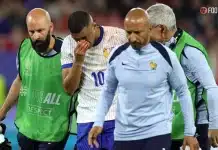
Sport has long been an arena of political – as well as physical – contest. This is especially true in Northern Ireland, where there are still stark political and religious divides between Catholic nationalists – who believe that all of Ireland should be united – and Protestant unionists – who prefer that Northern Ireland remains part of the United Kingdom. Because of this, whether you support the Republic of Ireland or Northern Ireland in the football has less to do with where you’re from, and more to do with which community you belong to.
The Northern Ireland team has historically received most of its support from the Protestant, unionist, working class community. Meanwhile, their Catholic, nationalist counterparts have tended to pledge their allegiance to the team south of the border. Now, for the first time, both Irish teams are represented at a major football tournament.
Historically, Catholic, nationalist football fans in Northern Ireland have felt uneasy about supporting their “national” team. In the past, unionist symbolism and sectarian chanting transformed the national stadium, Windsor Park, into a hostile space, where many Catholics and nationalists felt unsafe and unwelcome. High profile sectarian incidents – including death threats made to former Northern Ireland captain Neil Lennon, who was Catholic – only served to heighten these tensions.
Now, Northern Ireland’s “Green and White Army” and the Republic of Ireland’s “Boys in Green” both travel to the UEFA European Championships with a cadre of enthusiastic and lively supporters. In the past, this situation would have been loaded with the potential for violent confrontation. But evidence suggests that social attitudes have evolved over time, leading to a wider, cross-community acceptance of the Northern Ireland football team.
Changing attitudes
Since the signing of the 1998 Good Friday Agreement, which established the Northern Irish Assembly, research has closely monitored public attitudes towards many aspects of life across the north of Ireland. In recent years, results have revealed some positive changes, particularly when it comes to the old sporting divisions.
For instance, in 2014, it was found that 63% of those surveyed believed that sport has the potential to break down traditional inter-community barriers. And in 2015, a major study of sport and social exclusion in Northern Ireland found that 84% of participants believe that sports are more open and inclusive than they were ten years ago.
Significantly, the report also revealed an increase in support for the Northern Ireland football team among the Catholic, nationalist community. Two thirds of Catholics surveyed stated a desire for greater support for the team from within their own community.
Considerable steps have been taken to remove the sectarian stigma from the Northern Ireland team, and instead place a growing emphasis on improving community relations. The Irish Football Association (IFA) – Northern Ireland’s football governing body – has embarked on a high profile campaign to reach out to those who historically would not have supported the team. The “Football for All” campaign’s mantra is to make sure football is welcoming and inclusive to all members of society in Northern Ireland. The campaign deserves great credit for its attempts to clean up the divisive image of the Northern Ireland football team.
A safer space
What’s more, restrictions have been placed on contested flags and emblems in the stadium, and “new” inclusive Northern Ireland chants and songs have been developed as a means of creating a more welcoming environment for all fans. As a result, the choice of following both teams through the Euros – rather than one or the other – has become a more palatable option for football supporters than ever before.
Efforts to bring fans together have also been made in Northern Ireland’s capital. Belfast City Council has erected fan zones in the Titanic Quarter; a space which represents Northern Ireland’s attempt to reinvent itself as a post-conflict, modern and cosmopolitan city.
The decision to screen both the Republic of Ireland and Northern Ireland matches in an area viewed as a “shared space” is significant; particularly since Belfast’s “Peace Walls” continue to physically divide residents of different political and religious creeds. Despite being screened live at different times (a result of both teams competing in different groups) the mingling of supporters – particularly Catholic, nationalist fans who opt to attend Northern Ireland match screenings – could reflect a society which is continuing its transition away from a divisive past.
Further research indicates that there is a growing clamour to consider starting an all-Ireland football team. Some politicians have supportedthis approach, which has already been adopted by the rugby and hockey unions. Most of the people in favour of this proposal come from the Catholic community (70%, compared to 39% in the Protestant community).
Accepting the full range of political and religious identities is an ongoing process in Northern Ireland’s “post-conflict” society. But people who choose to support one team over the other should not be chastised, and those who call for support across the community divide must accept that any reluctance from Catholic or nationalist fans is based on past experience. Instead, the right to support either the Republic of Ireland, or Northern Ireland – or both at once – should be welcomed, as an example of how society in the North is maturing, and learning to overcome its old divisions.
Assistant Professor Conflict Resolution of Trinity College Dublin. This article was originally published on The Conversation.)



